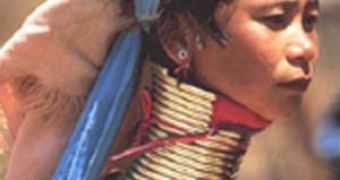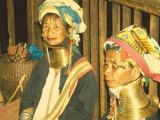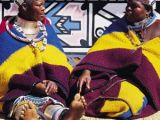In the border mountains between Burma and Thailand live the Kayan (known also as Padaung) people, related to the Burmeses and Tibetans.
These are not to be confused with the Malayan people with the same name from Borneo, related to Dayaks. Today, their tribe numbers around 40,000 souls. Visitors to their villages are amazed by the neck rings worn by the women of the tribe. The neck rings of a woman are, in fact, a single brass coil placed around the neck. The first coil is applied when the girl is five years old and with the growing is replaced by a longer coil. The length of the coil and the added weight presses the clavicle and the rib cage, resulting in the appearance of a very long neck. In fact, the neck does not elongate, this is impossible.
The "secret" of the "giraffe" women is that the clavicle and the ribs descend 45 degrees down from their normal position. The maximum weight of a coil is of 5 kg. This ancient tradition has unknown roots. The coils may have made Kayan women unattractive to slave trade. Some say that the coils are against tiger bite. More likely, it reflects the neck of a dragon.
For the Kayan women, the coils confer them a tribal identity, associated with beauty. In fact, the coils ensure that Kayan women will marry only inside their own tribe. The rings, once on, are seldom removed, as it is a somewhat lengthy procedure. Many thought that unfaithful women got, as a punishment, their coils removed, which led to their suffocation because their neck broke, but this is nonsense. Many women removed the coils when they felt it as obsolete or for medical examinations.
But most women prefer to wear the rings once their neck are elongated, because the skin portion kept so many years under the brass is often bruised and discolored. And many, after ten years or more of continuous wear, feel the collar like an integral part of the body. Kayan women wear coils also around their knees, ankles and wrists, but this will never capture the attention of the foreigners.
In South Africa, women of Ndebele people (about 600,000), closely related to Zulu, wear also neck rings (photo bellow). The practice starts when they get married, around 12 years of age. But their neck rings differ greatly of those of the Kayan, because the rings are individual, so they do not press against the rib cage and do not produce the impression of the elongated necks.

 14 DAY TRIAL //
14 DAY TRIAL // 

